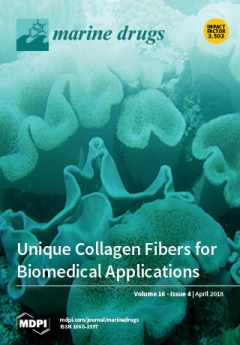A previously unreported
bis-indolyl benzenoid, candidusin D (
2e) and a new hydroxypyrrolidine alkaloid, preussin C (
5b) were isolated together with fourteen previously described compounds: palmitic acid, clionasterol, ergosterol 5,8-endoperoxides, chrysophanic acid (
1a), emodin (
1b),
[...] Read more.
A previously unreported
bis-indolyl benzenoid, candidusin D (
2e) and a new hydroxypyrrolidine alkaloid, preussin C (
5b) were isolated together with fourteen previously described compounds: palmitic acid, clionasterol, ergosterol 5,8-endoperoxides, chrysophanic acid (
1a), emodin (
1b), six
bis-indolyl benzenoids including asterriquinol D dimethyl ether (
2a), petromurin C (
2b), kumbicin B (
2c), kumbicin A (
2d), 2″-oxoasterriquinol D methyl ether (
3), kumbicin D (
4), the hydroxypyrrolidine alkaloid preussin (
5a), (3
S, 6
S)-3,6-dibenzylpiperazine-2,5-dione (
6) and 4-(acetylamino) benzoic acid (
7), from the cultures of the marine sponge-associated fungus
Aspergillus candidus KUFA 0062. Compounds
1a,
2a–e,
3,
4,
5a–b, and
6 were tested for their antibacterial activity against Gram-positive and Gram-negative reference and multidrug-resistant strains isolated from the environment. Only
5a exhibited an inhibitory effect against
S. aureus ATCC 29213 and
E. faecalis ATCC29212 as well as both methicillin-resistant
S. aureus (MRSA) and vancomycin-resistant enterococci (VRE) strains. Both
1a and
5a also reduced significant biofilm formation in
E. coli ATCC 25922. Moreover,
2b and
5a revealed a synergistic effect with oxacillin against MRSA
S. aureus 66/1 while
5a exhibited a strong synergistic effect with the antibiotic colistin against
E. coli 1410/1. Compound
1a,
2a–e,
3,
4,
5a–b, and
6 were also tested, together with the crude extract, for cytotoxic effect against eight cancer cell lines: HepG2, HT29, HCT116, A549, A 375, MCF-7, U-251, and T98G. Except for
1a,
2a,
2d,
4, and
6, all the compounds showed cytotoxicity against all the cancer cell lines tested.
Full article






